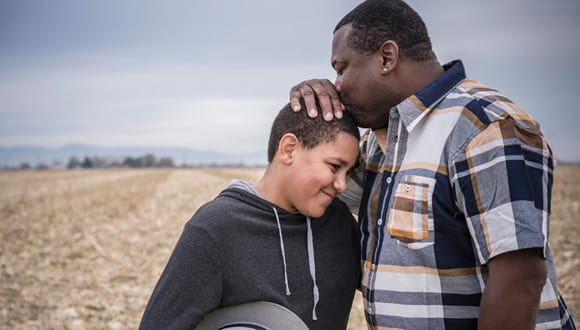5 Facts Every Guy Should Know About Male Breast Cancer
Oct. 18, 2021 - Katie McCallumMost everybody thinks of breast cancer as a woman's disease, but it's important to know that guys can get breast cancer, too — just much less frequently.
"While the shape and form of breasts vary between men and women, men still have small amounts of breast tissue and other underlying structures, including milk ducts," says Dr. Jorge Darcourt, medical oncologist at Houston Methodist. "Though these ducts are nonfunctional in men, it's where male breast cancer most frequently begins."
And, as with all types of cancer, the sooner male breast cancer is diagnosed, the better.
Since breast cancer isn't typically top-of-mind for most men, Dr. Darcourt is here to provide five fast facts every guy needs to know about male breast cancer.
1. Male breast cancer is on the rise
"Breast cancer accounts for less than 1% of the cancers diagnosed in American men each year, but studies suggest that the incidence of male breast cancer is rising," says Dr. Darcourt.
In fact, one study suggests that breast cancer in men has increased 25% over the last 25 years.
That same study also found that men were more likely to present with a more advanced stage breast cancer at the time of diagnosis as women. Still, male breast cancer is caught in the early stages more often than not. This is important since early-stage breast cancer is easier to treat.
"Although male breast cancer is certainly one of the rarer forms of cancer, it's important for men to be aware of it," Dr. Darcourt stresses.
2. Male breast cancer is more common in older men
Male breast cancer can occur at any age, but a man's risk rises with increasing age. It's most commonly diagnosed in men in their 60s.
"There are ways to screen for breast cancer in men, but, since it is so rare, common options, including screening mammograms, aren't likely to benefit the population at large," says Dr. Darcourt. "This is why it's important for men to know the signs of male breast cancer and not brush off any concerning symptoms."
3. Genetics and family history increase a man's risk of developing breast cancer
Like female breast cancer, male breast cancer can have a genetic component or inheritance pattern to it.
"Having a mutation in one of the BRCA genes increases a man's risk of developing breast cancer," explains Dr. Darcourt, who notes that a BRCA2 defect increases the risk more than a BRCA1 defect. "These mutations are often inherited, but not always."
Exactly how often is male breast cancer caused by changes that "run in the family?" The American Cancer Society reports that 20% of men with breast cancer have a close relative who has or had breast cancer.
"Other mutations that may contribute to breast cancer in men include changes to the PTEN, TP53, PALB2 and CHEK2 genes," adds Dr. Darcourt.
Other male breast cancer risk factors include:
- Increasing age
- Taking an estrogen-related drug to treat a health condition, such as prostate cancer
- A genetic syndrome called Klinefelter's syndrome
- Liver cirrhosis or liver disease
- Obesity
- Heavy alcohol use (potentially due to the effects this can have on the liver)
- Inflamed testicles (orchitis), undescended testes (cryptorchidism) or a past testicular injury
"Having a mutation in one of these genes, a family history or another risk factor doesn't mean a man will develop breast cancer at some point in his lifetime, but it does mean that his risk is higher," says Dr. Darcourt. "Because of this, he should be more aware of the signs and symptoms of male breast cancer and alert his doctor as soon as he notices something concerning."
5. Male breast cancer symptoms include lumps and visible changes to the skin
Like breast cancer in women, male breast cancer often presents with a lump.
"Because men have less breast tissue than women, it's much easier for men and their doctors to feel a lump," adds Dr. Darcourt. "On the other hand, having less tissue also means the cancer doesn't need to grow very large before it can spread outside of the breast — into the underlying muscle, for instance. This is why it's so critical for men to speak up when they notice a lump — even if it feels small and harmless."
The full list of symptoms of breast cancer in men include:
- A firm mass in the breast (which is usually painless)
- Fixation of the mass to the underlying skin
- Nipple retraction
- Dimpling of the skin
- Redness of or discharge from the nipple
Even if you don't have a family history of breast cancer, consult with your doctor if you notice a lump or concerning change in the appearance of the skin covering your breast or your nipple. The doctor can perform a breast exam and begin ordering the tests needed to rule out or diagnose breast cancer.
5. Breast lumps aren't always cancer, but they should still be checked out
While male breast cancer often results in a lump you can feel, not all breast lumps are cancerous.
"Gynecomastia, which is a benign increase in the amount of breast tissue, is more common than male breast cancer and can also feel and appear like a small growth," says Dr. Darcourt. "Additionally, papillomas and fibroadenomas are abnormal but benign masses that can occur in breast tissue, although they're fairly rare in men."
But while feeling a breast lump isn't necessarily cause for immediate panic, it shouldn't be brushed off.
"Not every breast lump is cancerous, but that's certainly not a reason to delay mentioning it to your doctor," says Dr. Darcourt. "The overall risk may be low, but remember, the earlier breast cancer is detected and treated, the better."


